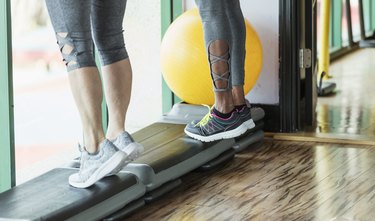
Soleus exercises strengthen your calf and help prevent injuries. The soleus muscle is one of two muscles in your calf. The other is the gastrocnemius muscle. When your knee is bent, the soleus muscle is responsible for lifting your heel, allowing the toes to point downward. It also helps to control the movement of the ankle and knee as they bend.
Video of the Day
Video of the Day
Tip
Soleus exercises include standing and seated heel raises, deep squats and calf flexion with a resistance band. A strong soleus helps to support the joints and prevent injuries.
Body Weight Soleus Exercises
One of the basic soleus exercises is calf raises, or standing heel raises, according to the American Council on Exercise. Begin this exercise with the ball of your foot on a step with your heel hanging over the edge. Slowly lower the heel until the ankle is fully flexed. Then raise up onto your toes, keeping the knee straight. You can perform this exercise with both legs or one leg at a time.
This exercise not only strengthens your soleus but it also works the gastrocnemius muscle and increases the range of motion in your ankle. Start with one set of 10 to 15 repetitions and add additional sets as your strength increases.
Another exercise that helps to strengthen and lengthen the soleus is a deep bodyweight squat, advises the National Exercise Trainers Association. This is a functional exercise that allows the soleus to perform its function of supporting and controlling the bend of the ankle and knee.
Resistance Soleus Exercises
There are several options to work your soleus using bands or weights. For example, try a seated heel raise with weights. This move is done with your knees bent, which deactivates the gastrocnemius, allowing the soleus to bear the load.
Begin sitting with the balls of your feet on a step in front of you. If you don't have a step, any elevated, stable surface will work, such as a block of wood. Hold a set of weights and rest them on your knee for added resistance. Lower and raise your heel for 10 to 15 repetitions.
Resistance bands also allow you to add additional resistance to strengthen the soleus muscle. Begin seated on a mat with both legs straight in front of you. Wrap a resistance band around the balls of your fee. Keeping the band taught and your knees straight, flex your toes back toward your body as far as you can, then point your toes to work both the soleus and gastrocnemius. You can also perform this exercise with bent knees to isolate the soleus.
Warming Up and Stretching
Whether you are doing soleus exercises, playing sports or any other workout, warm up for five to 10 minutes before exercising. Walking or biking are good warm-up options. Cool down after your workout with five to 10 minutes of walking or biking at an easy pace. Finish by stretching your calf muscles.
Try the wall stretching exercise described by the American Council on Exercise. Stand one arm's length away from the wall and place your palms on the wall just below shoulder height. Keeping your core engaged, step back with one leg. Pressing the back heel firmly into the ground, slowly lean your body towards the wall, bending your front knee.
Keep your back leg straight to stretch both the soleus and gastrocnemius muscles. To isolate the stretch to the soleus muscle, simply bend the back knee during the stretch, keeping the heel planted on the ground. Hold the stretch for 15 to 30 seconds and repeat two to four times on each leg.
Injury to the Calf
Injury to the soleus may be caused by overuse or a sudden movement, such as when you push off the leg when playing sports like tennis or soccer. If you do have a mild strain in your muscle, you can treat it with rest and ice to the injured area, advises the University of Wisconsin Health. You can also wrap the leg with a bandage and elevate your leg to reduce swelling.
If you experience pain in your calf, stop exercising and consult your doctor as more serious injuries may require additional treatment such as physical therapy or surgery.
- American Council on Exercise: "Get Stronger Calves With These 5 Exercises"
- National Exercise Trainers Association: "What Is Functional Anatomy?"
- University of Wisconsin Health: "Calf Muscle Injury"
- National Federation of State High School Associations: "Preventing and Treating Calf Injuries"
- American Council on Exercise: "Standing Dorsi-Flexion (Calf Stretch)"